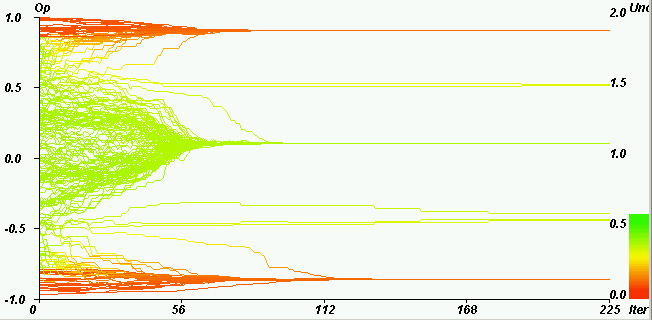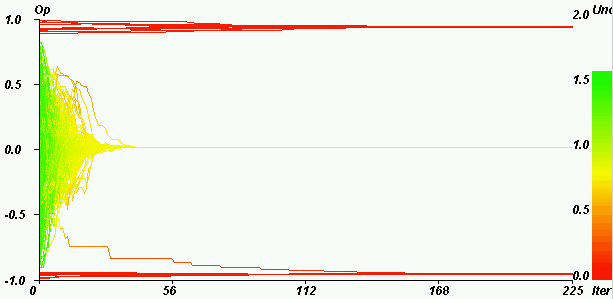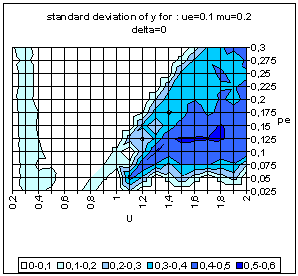![]()
Guillaume Deffuant, Frédéric Amblard, Gérard Weisbuch and Thierry Faure (2002)
How can extremism prevail? A study based on the relative agreement interaction model
Journal of Artificial Societies and
Social Simulation vol. 5, no. 4
<http://jasss.soc.surrey.ac.uk/5/4/1.html>
To cite articles published in the Journal of Artificial Societies and Social Simulation, please reference the above information and include paragraph numbers if necessary
Received: 17-Jul-2002 Accepted: 20-Sep-2002 Published: 31-Oct-2002
 |
| Figure 5. Example of central convergence. Horizontal axis: iterations. Vertical axis: opinions. Coloured axis: uncertainties. pe = 0.2, u = 0.4, µ = 0.5, delta = 0, ue = 0.1, N = 200. The majority (96%) of the moderate agents (initially green, between the two extremes) are not attracted by the extremes. |
 |
| pe = 0.25, u = 1.2, µ = 0.5, delta = 0, ue = 0.1, N = 200. The initially moderate agents (initially green, between the two extremes) split and become extremists (43% on the positive side, 56% on the negative side). |
 |
| Single extreme convergence. The majority (98.33%) of initially moderate agents (initially green, between the two extremes) is attracted by the positive extreme. |
 |
| Figure 8. Central convergence for the same parameters as in figure 7. The majority stays at the centre (Only one agent joins the negative extreme). |
  |
| Figure 9. Typical pattern of average and standard deviation of indicator y (50 simulations at each point of the graph) as a function of the uncertainty of the moderate agents (U) and the global proportion of extremists (pe) for delta = 0 (top) and delta = 0.1 (bottom). The other parameters are fixed: uncertainty of the extremists ue = 0.1, intensity of interactions µ = 0.2, initial relative difference between the extremists, delta = 0.1. On the graph of average y, the yellow or white zones on the left part correspond to central convergence, the orange, typically in the upper middle part to both extremes, and brown at the bottom right to single extreme. |